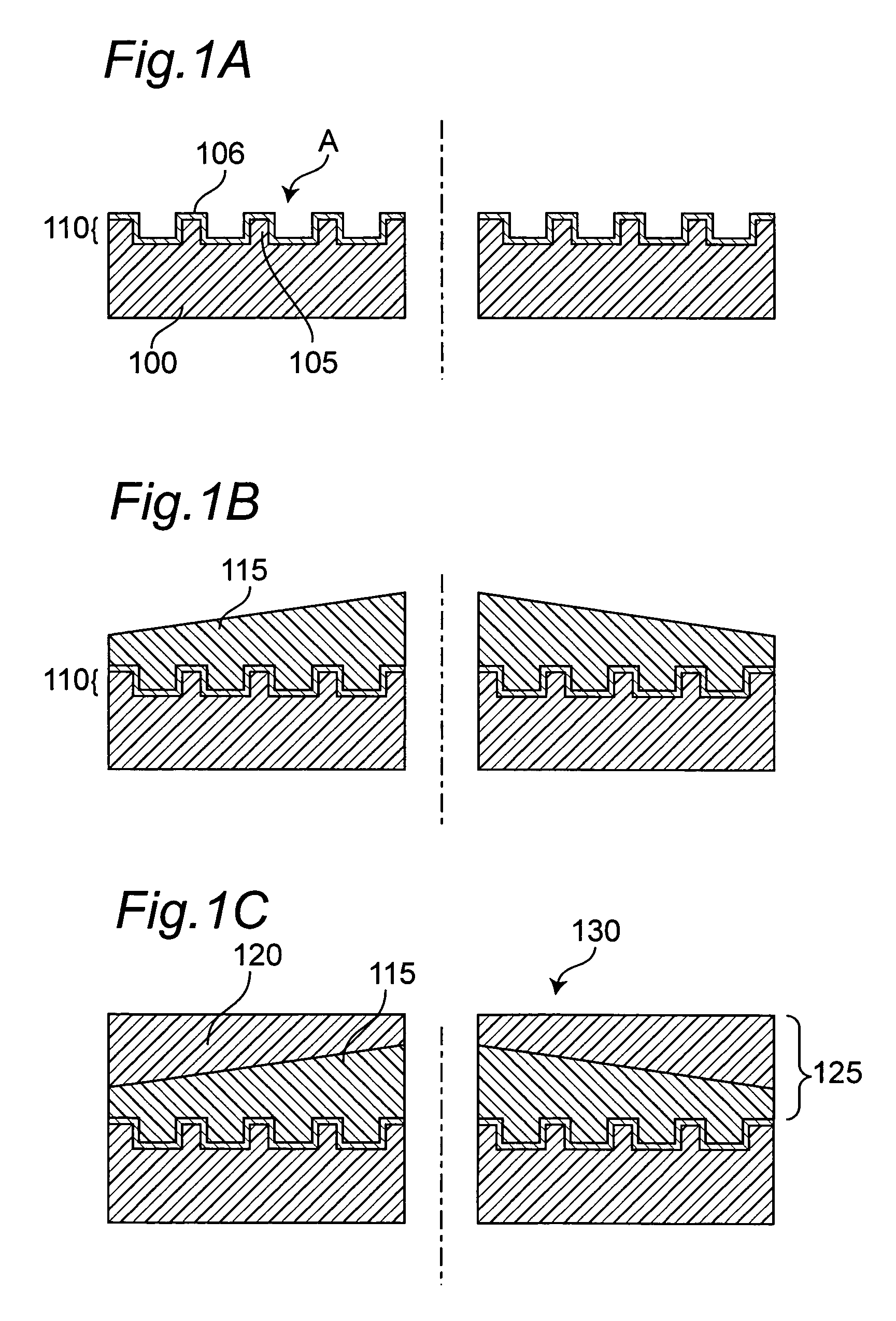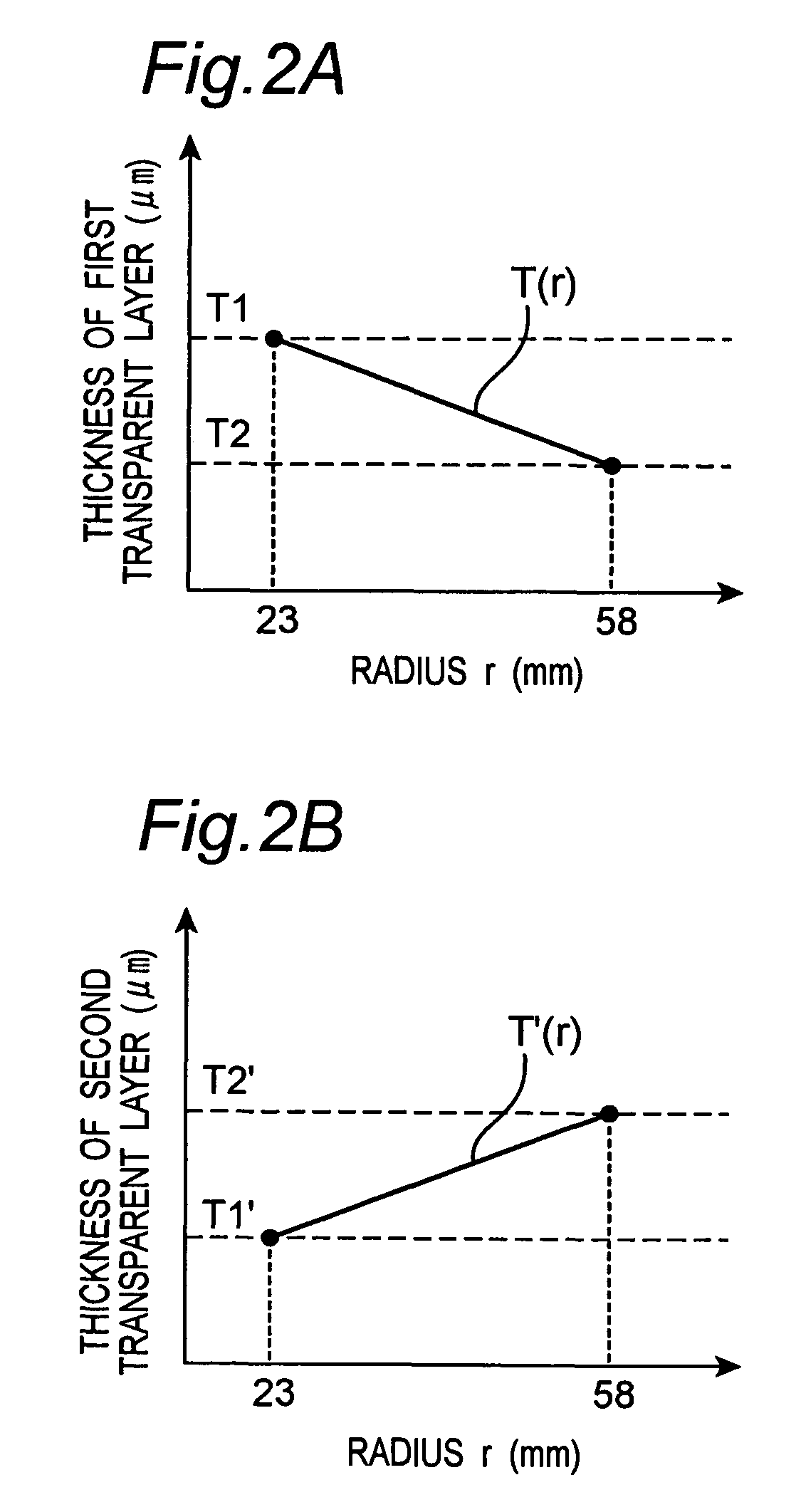Manufacturing method of optical information recording medium
a manufacturing method and optical information technology, applied in the field of manufacturing optical information recording media, can solve the problems of disc out of focus colliding with the lens, damage to the surface of the transparent cover layer on the record/reproduction side, and inability to produce good recording and reproducing characteristics, and achieve high shrinkage percentage , the effect of efficiently controlling warpage to a small amoun
- Summary
- Abstract
- Description
- Claims
- Application Information
AI Technical Summary
Benefits of technology
Problems solved by technology
Method used
Image
Examples
first embodiment
[0037]FIGS. 1A to 1C show an embodiment of a manufacturing method of the optical information recording medium according to the invention. Referring to FIG. 1A, first, a signal substrate 100 is prepared with a thickness of 1.1 mm. On a principal surface A of the signal substrate 100, concavities and convexities 105 are formed according to signals. The signal substrate 100 is made of plastic such as polycarbonate and acrylics and generally formed by an injection molding process. Alternatively, the 2P method may be performed to transfer the concavities and convexities 105 according to signals to the supporting substrate. A recording film 106 is formed on the concavity and convexity 105 according to signals to constitute a signal recording layer 110. The recording film 106 is a multilayer or monolayer film including at least one of a metal reflection film, a semiconductor film (for example, a phase change film such as a GeSbTe film), a dielectric film, and a pigment film. The method of ...
second embodiment
[0055]Here is a description of a manufacturing method of a recording medium having two signal recording layers formed in the direction of depth of the recording medium.
[0056]Referring to FIG. 6A, on a signal substrate 100, formed are a first signal recording layer 110 and a second signal recording layer 1000 formed under the first layer 110 via a separation layer 1001. The second signal recording layer 1000 includes concavity and convexity 1005 according to second signals and a second recording film 1006.
[0057]As shown in FIG. 6B, the first transparent layer 115 is formed on the first signal recording layer 110, and as shown in FIG. 6C, the second transparent layer 120 is formed thereon, by the method according to First Embodiment.
[0058]The thickness of the separation layer 1001 is determined depending on the numerical aperture of the lens used in recording and reproduction. The numerical aperture is determined depending on the recording densities of concavity and convexity 105 and ...
third embodiment
[0059]In this embodiment, provided is a method of forming the first transparent layer by screen printing. The second transparent layer is formed by the method of the above embodiment.
[0060]FIG. 7A shows a screen for use in forming the first transparent layer in this embodiment. Referring to the drawing, a screen 500 has a number of holes 510 each having a diameter D(R) depending on the distance (the diameter) R from the center and are concentrically arranged. FIG. 7B shows the relationship between the diameter D(R) of each hole and the diameter at which the hole is provided on the screen 500. It is preferred that the diameter D(R) of the hole decreases as the distance R increases, as shown in the drawing. The screen 500 is placed on the signal substrate 100, and according to the screen printing, the radiation cure type resin is allowed to pass through the screen 500 using a spatula or the like so that the first transparent layer 115 is provided in a similar form to that of the First...
PUM
| Property | Measurement | Unit |
|---|---|---|
| Length | aaaaa | aaaaa |
| Fraction | aaaaa | aaaaa |
| Angle | aaaaa | aaaaa |
Abstract
Description
Claims
Application Information
 Login to View More
Login to View More - R&D
- Intellectual Property
- Life Sciences
- Materials
- Tech Scout
- Unparalleled Data Quality
- Higher Quality Content
- 60% Fewer Hallucinations
Browse by: Latest US Patents, China's latest patents, Technical Efficacy Thesaurus, Application Domain, Technology Topic, Popular Technical Reports.
© 2025 PatSnap. All rights reserved.Legal|Privacy policy|Modern Slavery Act Transparency Statement|Sitemap|About US| Contact US: help@patsnap.com



